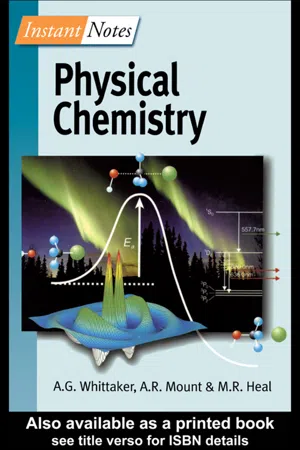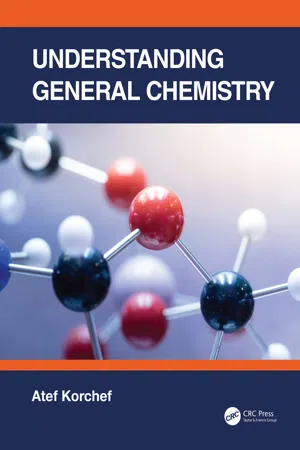Enthalpy Changes
Enthalpy changes refer to the heat energy exchanged during a chemical reaction at constant pressure. They are represented by the symbol ΔH and can be either exothermic (release heat) or endothermic (absorb heat). Enthalpy changes are crucial in understanding the energy transformations that occur in chemical reactions.
8 Key excerpts on "Enthalpy Changes"
- eBook - ePub
- Gavin Whittaker, Andy Mount, Matthew Heal(Authors)
- 2000(Publication Date)
- Taylor & Francis(Publisher)
...The enthalpy change, ΔH, for finite changes at constant pressure is given by the expression Δ H =Δ U + p V, so making the enthalpy change for a process equal to the heat exchange in a system at constant pressure. For a chemical system which releases or absorbs a gas at constant pressure, the enthalpy change is related to the internal energy change by Δ H =Δ U +Δ n.RT, where Δ n is the molar change in gaseous component. Properties of Enthalphy Enthalpy is a state function whose absolute value cannot be known.Δ H can be ascertained, either by direct methods, where feasible, or indirectly. An increase in the enthalpy of a system, for which Δ H is positive, is referred to as an endothermic process. Conversely, loss of heat from a system, for which Δ H has a negative value, is referred to as an exothermic process. The enthalpy change arising from a temperature change at constant pressure is given by the expression Δ H = C p Δ T, providing that C p does not appreciably change over the temperature range of interest. Where Cp does change, the integral form of the equation, is used. In a chemical reaction, the enthalpy change is equal to the difference in enthalpy between the reactants and products: Kirchhoff’s law The value of ΔH for a reaction varies considerably with temperature. Kirchhoff’s s equation, derived from the properties of enthalpy, quantifies this variation. Where C p does not appreciably change over the temperature range of interest, it may be expressed in the form Δ H T2 -Δ H T1 =Δ C p Δ T, or as, where Δ C p is a function of temperature. Related topics The first law (B1) Entropy and change (B5) Thermochemistry (B3) Free energy (B6) Entropy () Statistical thermodynamics (G8) Enthalpy The majority of chemical reactions, and almost all biochemical processes in vivo, are performed under constant pressure conditions and involve small volume changes...
- Kevin Reel, Derrick C. Wood, Scott A. Best(Authors)
- 2014(Publication Date)
- Research & Education Association(Publisher)
...According to the first law of thermodynamics, heat lost by a hotter object is gained by a colder object. In contrast, enthalpy (H) refers to the energy released or absorbed by a chemical reaction. Unless there is pressure–volume (PΔV) work performed by the system, changes in enthalpy (ΔH) are essentially the same as the heat exchanged during a reaction. ΔH is the difference between the enthalpy of the products and the enthalpy of the reactants. Exothermic processes describe a heat transfer from the system into the surroundings. Heat is given off during an exothermic reaction (ΔH < 0) and the products of the reaction have less enthalpy than the reactants. Endothermic processes undergo a transfer of energy from the surroundings into the system. Heat is absorbed during an endothermic reaction (ΔH > 0), because energy must be put into the reaction to move it from reactants to products. The products of the reaction have more enthalpy than the reactants. Energy diagrams for exothermic and endothermic reactions can be found in Chapter 11, Kinetics. Heat Capacity, Specific Heat, and Units Heat capacity is a measure of how much an object changes temperature when a given amount of heat is absorbed. For example, when a metal pan is placed on a stovetop it only takes a few moments for the pan to get really hot. This is because metals have a low heat capacity. The units for heat capacity are in J/°C (J/K) as determined by the equation: Specific heat (c) is related to heat capacity because it defines the quantity of heat required to raise 1 gram of substance by 1°C (or 1 Kelvin). The energy unit of the calorie was originally defined in the early 1800s from the specific heat of water, which is the amount of energy required to raise 1 gram of water by 1°C. Of course, calories are not the same as Calories. The “food calorie” is sometimes written with the capital “C” and is actually kilocalories. Since then, scientists have embraced the SI unit of the Joule for measuring heat...
- eBook - ePub
- Atef Korchef(Author)
- 2022(Publication Date)
- CRC Press(Publisher)
...They release energy. 13. A phase change occurs when we cross the lines or the curves on the phase diagram. The temperature remains constant during a phase change (Figure 5.9) and energy is used to overcome attractive forces between molecules. 14. For a chemical reaction, when Δ H rxn < 0 the reaction is exothermic, when Δ H rxn > 0 the reaction is endothermic and when Δ H rxn = 0 the reaction is athermic (no heat is gained or lost). 15. The standard enthalpy of formation, designated by Δ H f °, is the change in enthalpy when one mole of a substance is formed under standard conditions (P = 1 atm and T = 25°C) from its pure elements under the same standard conditions. Conventionally, the standard enthalpy of formation of a pure element in its most stable form is zero. 16. Bond breaking requires energy. The energy required to break one mole of that chemical bond is called the bond enthalpy or bond dissociation enthalpy. It is also a measure of the bond strength. Bond enthalpy values are always positive since bond breaking is an endothermic process. However, bond making is an exothermic process (it releases energy). Note that a chemical reaction can be described as the breaking of bonds in the reactants and the making of bonds in the products. Thus, if the bond enthalpies of the reactants and products are known, we can calculate the standard enthalpy of the reaction, Δ H rxn ° : Δ H rxn ° = ∑ Δ H broken bonds − ∑ Δ H formed bonds 17. Hess’s law states that, if a chemical reaction is carried out in a series of steps, the enthalpy change ΔH for the overall reaction is equal to the sum of the Enthalpy Changes for the individual steps...
- eBook - ePub
- Jeffrey Gaffney, Nancy Marley(Authors)
- 2017(Publication Date)
- Elsevier(Publisher)
...In a physical sense, it can be viewed as the energy required to create the system at equilibrium (internal energy) plus the amount of energy required to create space for the system by expanding its volume against a constant pressure (PV). This new state function allows us to be able to predict the changes in energy for chemical reactions at constant pressure. Although the value of enthalpy for an equilibrium state cannot be calculated directly, the change in enthalpy (Δ H) between equilibrium states can be calculated and is given by; Δ H = Δ E + Δ PV = q + w + Δ PV (9) For chemical reactions at constant pressure, where the only work done by the system is pressure-volume work, w p is equal to − P Δ V and the change in enthalpy becomes; Δ H p = q p – P Δ V + P Δ V Δ H p = q p (10) So, for the condition of constant pressure, the change in enthalpy is simply equal to the heat transferred to or from the system (q p). Similar to Δ E v, Δ H p will also be negative for exothermic reactions as the heat released. at constant pressure will move to the surroundings from the system, and Δ H p will be positive for endothermic reactions when heat must be supplied to the system for the reaction to occur. Heat capacities are also most important under conditions of constant pressure since most materials and chemical species are used under these conditions. The specific heat capacity of a substance under conditions of constant pressure (C p) is related to the change in internal energy as; C p = q p / m Δ T = Δ H p / m Δ T (11) Changes in enthalpy are also associated with the phase transitions discussed in Chapter 1. Since phase transitions are caused by heat added to or released from a system at constant pressure, they are accompanied with a change in enthalpy according to Eq. (10). The Enthalpy Changes that occur in each phase transition are related to each other as shown in Fig. 8.3. The length of the arrows in Fig...
- eBook - ePub
- Antonio Blanco, Gustavo Blanco(Authors)
- 2017(Publication Date)
- Academic Press(Publisher)
...That difference is the same, independent of the steps involved in the reaction. Measuring the energy content of a system can be difficult; it is easier to determine the energy change that takes place between the initial and final states (change is symbolized by the Greek capital letter delta, ∆). The most common form of energy is heat. Almost all chemical processes are accompanied by heat consumption or production; the first are referred as endothermic and the second, as exothermic reactions. According to the first law of thermodynamics, it is possible to determine the energy change in a reaction by measuring the gain or loss of heat in the system in conditions of constant temperature and pressure. This can be performed using a calorimetric pump, which determines the energy released by the reaction measuring the temperature of a known volume of water surrounding the calorimeter. Multiplying the temperature increase by the weight of water, the heat released can be estimated. This is usually measured in calories. A calorie (cal) is the amount of heat required to raise the temperature of 1 g of water from 14.5 to 15.5°C. The kilocalorie (kcal or Cal), a 1000 times greater, is commonly used. The unit Cal has been widely used by biochemists. Currently the Joule or most often the kilojoule (kJ), units of the International System (IS), are preferred to express energy. (Joule = 10 7 ergs. Erg, unit of work, corresponds to the work done by 1 Dine along 1 cm. Dine is the force acting during 1 s on a 1 g mass, moving it with a speed of 1 cm/s.) When a substance is oxidized, energy is produced and heat is released to the environment. The magnitude of this “heat of combustion” depends on the molecular structure of the substance and the remaining energy content in the products formed...
- eBook - ePub
- Adrian Dingle, Derrick C. Wood(Authors)
- 2014(Publication Date)
- Research & Education Association(Publisher)
...mass, c is the specific heat capacity of the substance being heated, and Δ T is the temperature change. vii. A plateau region represents a stage where two phases are in equilibrium with one another. Where the gas is condensing, the amount of energy that is removed can be calculated using q = (ΔH vaporization)(moles). Where the liquid is freezing, the amount of energy that is removed can be calculated using q = (ΔH fusion)(moles). These are exothermic processes because energy must be removed. III. Calorimetry A. Calorimetry is an experimental technique used to measure the change in energy of a chemical reaction or phase change. 1. General principles: Put a chemical reaction or phase change in contact with a heat bath (usually water). We can measure the change in temperature of the heat bath. Knowing the heat capacity of the heat bath, we can calculate the energy change in the heat bath by applying: The energy change in the heat bath will be the same magnitude in energy as the chemical reaction or phase change, just with the opposite sign. If the heat bath gains energy, its temperature goes up, meaning the energy of the chemical reaction or phase change went down (it lost energy) and vice versa. Enthalpy Changes where energy is released are exothermic and have negative values. Enthalpy Changes where energy is absorbed are end othermic and have positive values. 2. Coffee cup calorimeter—Styrofoam cups are commonly used as insulators in the high school chemistry lab, to measure temperature changes without a loss of energy to the surroundings. Practice Question 1. If 5.00 g of urea are added to 90.00 g of water in a coffee cup calorimeter, the temperature of the contents of the cup falls by 3.100 o C...
- eBook - ePub
- Kevin R. Reel(Author)
- 2013(Publication Date)
- Research & Education Association(Publisher)
...The measured change in temperature of the calorimeter identifies how much heat is either absorbed or contributed to the reaction inside it. • The heat given off by the reaction equals the heat absorbed by the calorimeter. Likewise, the heat absorbed by the reaction equals the heat given off by the calorimeter. • Coffee cup calorimeters assume that all the heat of a reaction is absorbed by water in the calorimeter. • Bomb calorimeters contain materials other than water that absorb the heat from the reaction. For bomb calorimeters, the heat absorbed equals the specific heat capacity of the calorimeter (in J/°C) multiplied by the change in the temperature of the calorimeter (ΔT). • Measured heats of reaction can be compared to heats of reaction that are estimated using heats of formation or bond energies. Example: A bomb calorimeter with a heat capacity of 10.8 J/°C is used to find the heat of combustion for a molecule. If the calorimeter increases in temperature by 82 °C during the reaction, what is the measured heat of combustion for the reaction? Solution: ΔH reaction = − q = −CΔT ΔH reaction = −10.8 J/°C × 82°C = −885.6 J SECOND LAW, ENTROPY, AND FREE ENERGY ENTROPY AND THE SECOND LAW OF THERMODYNAMICS • Entropy is a measure of disorder, and carries the units of J/K. • Entropy is a state function...
- eBook - ePub
- Warren C. Strahle, William A. Sirignano, William A. Sirignano(Authors)
- 2020(Publication Date)
- Routledge(Publisher)
...2 CHEMICAL THERMODYNAMICS 2.1 INTRODUCTION Thermodynamics is an empirical science dealing with the properties of substances and their energetics. It applies to systems of a single phase and multiple phases. For purposes here it also applies to systems of varying chemical composition. The subject of chemical thermodynamics applies to fixed mass and flowing systems, just as in the case of fixed composition systems. The subject simply becomes a bit more complex when chemical change is involved, than in the case of fixed composition systems. Since combustion involves composition changes, however, this complexity must be accepted as necessary. Thermodynamics enables us to calculate the energetics of system changes in composition. As such it enables us to determine, for example, the temperature and pressure changes when a system undergoes a chemical transformation. It will be seen that thermodynamics can also be used to tell us what the composition change will be when a system undergoes a reaction. It is not used, however, to determine rates of chemical transition. That is the subject of a following chapter on chemical kinetics. The subject of thermodynamics is only concerned with beginning and end thermodynamic states for a system, with no concern for the process path between them. Nevertheless, it is an essential science in combustion. 2.2 PROPERTIES OF SUBSTANCES We shall deal with solids, liquids and gases. For solids and liquids we will use the actual measured thermodynamic properties of the substances. So, for example, any thermodynamic equation of state such as a relation between pressure, temperature and volume for liquids and solids will be the actual measured relation. For gases, however, but with good approximation, we will always assume them to be thermally perfect gases. The term “thermally perfect” means that the gas obeys the equation of state (2.1) where V is a fixed system volume, ρ is pressure and T is absolute thermodynamic temperature...







